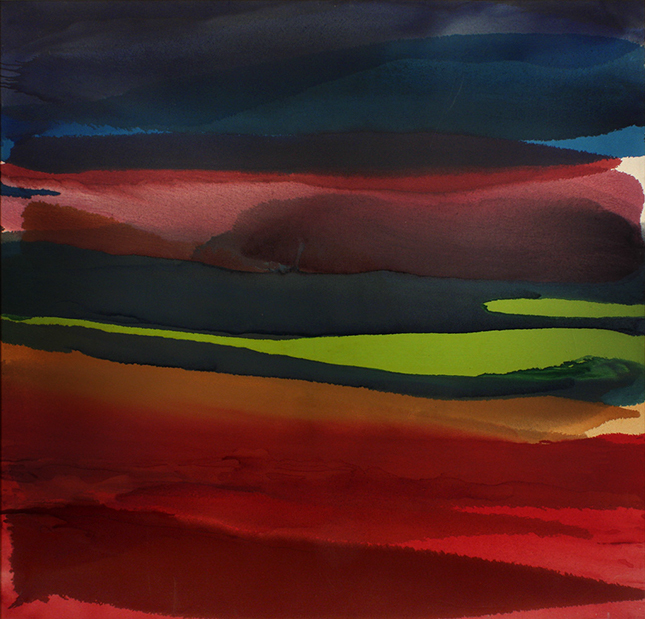
Frederic Karoly (Hungarian, 1898–1987)
Concerto Grosso Fugue by Bloch–Interpretation, 1959
Acrylic on canvas
Gift of Mr. Morton D. May (65.332)
Height: 198.1 cm Width: 219 cm
Additional images may be viewed in Argus
Guiding Questions
This painting was inspired by a piece of music. What do you think that piece of music might sound like? What do you see that makes you say that?
What might you be able to tell about the techniques the artist used to paint this work?
About the Art
This work of art is an example of a technique called stain painting. The artist pours very thin paints directly onto the canvas allowing it to seep and flow across the canvas and into other colors. This technique is part of an art movement called Post-Painterly Abstraction and was popular in the 1950s. Helen Frankenthaler and Morris Louis were a few of its most famous artists. Karoly and the other artists wanted to make art that did not show evidence of the artist’s role in it, such as brushstrokes or controlled shapes and lines. By pouring the paint onto the canvas, the artists were removing themselves from direct control over the final outcome and letting the canvas and paint do the work.
The title of the painting tells us that Karoly was inspired by a musical composition penned in 1925 by the celebrated American composer Ernest Bloch (1880–1959). This musical piece is notable for the fusion of a modern harmonic language with mid-eighteenth-century classical techniques. The sweeping and saturated veils of paint on the canvas provide an interesting visual parallel to the forceful chords and rich texture of Bloch’s music.
About the Artist
Frederic Karoly was a Hungarian painter born in Budapest in 1893. He moved to the United States in 1926. He found success as a fashion and fabric designer and worked as fashion director for Simplicity Patterns. Karoly was a member of a group of painters based in Washington, DC, known as the Washington Color Painters. Members of this group responded to Abstract Expressionism through the non-gestural, abstract paintings that considered the optical effects resulting from the juxtaposition of different colors.
Connections
Compare and contrast with Grace Hartigan’s Abstract Expressionist painting, The Gallow Ball.
Listen to Bloch’s Concerto Grosso (http://www.youtube.com/watch?v=MQKV72k0a1c).
How did Karoly reflect the music in his painting? (For more music and art connections, see Benton’s Portrait of a Musician)
Additional Resources
Abstract Expressionism, Metropolitan Museum of Art: http://www.metmuseum.org/toah/hd/abex/hd_abex.htm
Post-Painterly Abstraction at the Guggenheim: https://www.guggenheim.org/search?s=Post-Painterly%20Abstraction&page=1